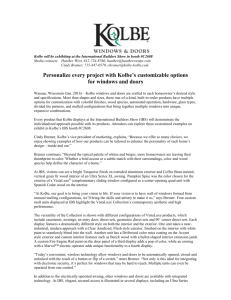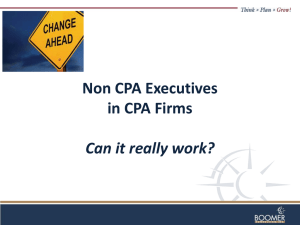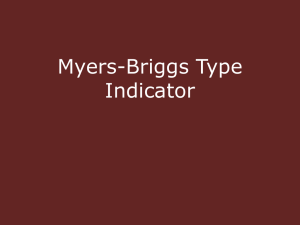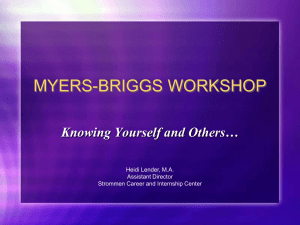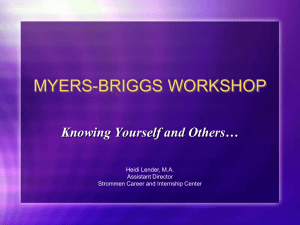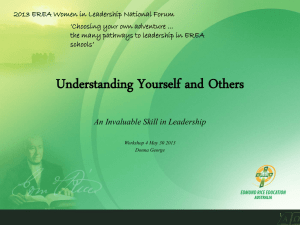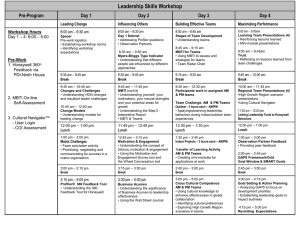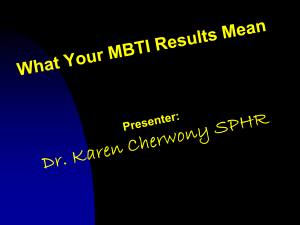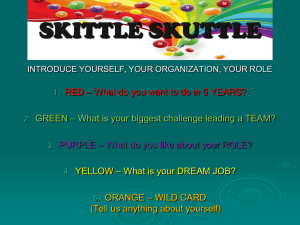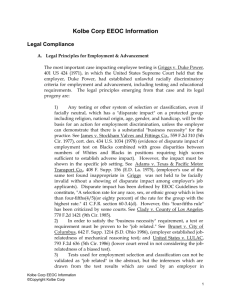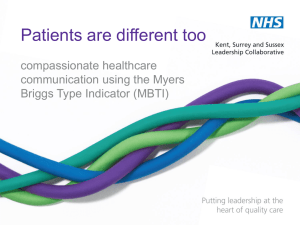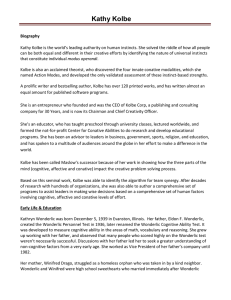Using Personality Assessment Tools: Understanding
advertisement
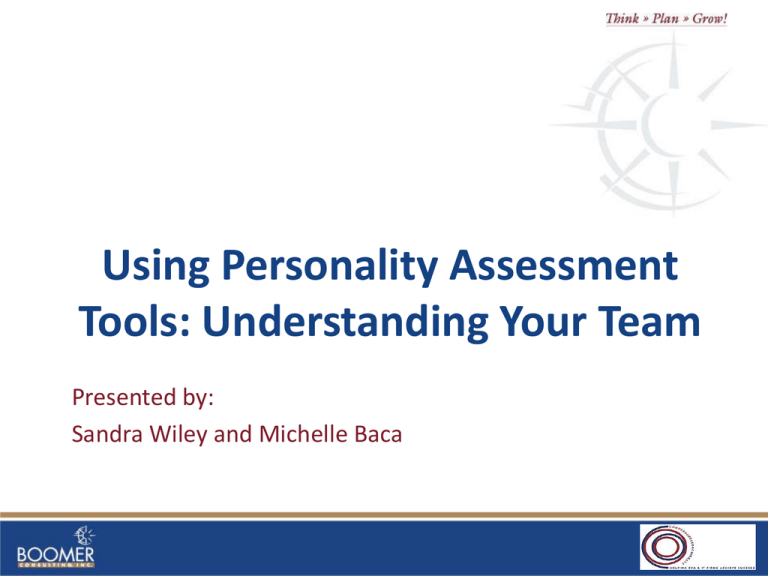
Using Personality Assessment Tools: Understanding Your Team Presented by: Sandra Wiley and Michelle Baca Speakers Polling Question • How many FTE (Full Time Equivalents) are in your firm? – 0-10 – 11-30 – 31-100 – 101 – 500 – 500+ Agenda • Identifying Personality and Instinctive traits – How and Why? • Common assessment tools to help you identify your personality type • The Kolbe Index • Myers-Briggs • Story time – Peer Success Stories Conative Cognitive Affective Cognitive = Thinking Assessed by IQ, SAT, Wonderlic, skills tests • Learned abilities • Knowledge from education, training, experience • Reasoning Affective = Motivation, Feelings Meyers Briggs • Personality • Values • Social style • Preference Conative = Instinct-based actions Kolbe Index • Innate Paths to Success • Modes of operation ( MO ) • Creative power • Form of productivity Productivity Process Productive Action Motivation Instincts Affective Conative Reason Will Cognitive Polling Question • What areas of the productivity process are you identifying and encouraging today in your firm? – Cognitive (Thinking) – Affective (Feeling) – Conative (Doing) – All Three – None of the Above People Challenges How thinking, feeling, and acting on instinct impact performance Lack of competency Personal Conflicts Misdirected efforts Thinking: Poor skills, knowledge, or judgment Affect: different approaches or incompatible desires Instincts: False efforts caused by working against a natural grain Common Assessment Tools • Cognitive – Wonderlick, Firm Developed • Affective – Meyers-Briggs, DISC, Predictive Index, Strengths Finder • Conative - Kolbe How to Choose? • • • • What are you trying to accomplish? What is your firm culture? What do you know already? What do you need to know in order to fix the challenges in the firm? Polling Question • Do you use an assessment tool in your firm today? If so, which one? – – – – – Meyers-Briggs Kolbe Other I don’t use any assessments today I am not sure The Kolbe Method Proven Answers • Identifies individuals’ instinctive strengths for increased productivity • Ensures having the right person in the right job • Reduces selection costs while increasing retention rates • Improves communication and job satisfaction • Pinpoints areas of organizational stress and prescribes solutions • Builds teams with the right talents for high performance Value of Kolbe • • • • • • • Individual – Children and Adults Improved Communication Sales Profile Coaching Profile Career Profile Hiring Decisions Diagnosing Team Viability 4 Action Modes MOs are formed by Kolbe Action Modes Fact Finder Follow Thru Gathering and communicating information Sorting and storing information Quick Start Implementor Dealing with risk and unknowns Handling space and tactile efforts Kolbe A™ Result Your Kolbe result is so individualized, only 5% of the population is likely to have one just like it. How you take action in these four instinct-based Action Modes® defines your MO Every ring on a Kolbe Continuum represents and equally positive trait Kolbe A™ Index Transition Result 12 Kolbe Strengths Everyone has a strength in each mode. Diversity in the combination of strengths creates a multitude of MOs. Methods of Communication Fact Finder: written words with data, citations, analogies, case studies, verifications Follow Thru: visuals with graphs, charts, diagrams, posters, outlines, maps, similes, patterns Quick Start: spoken words with ad libs, improvised metaphors, visuals, bullet points, intense colors Implementor: tangibles with props, models, demonstrations, texture, machinery, body language Sense of Time and Conation Fact Finder: focuses on the past, builds on experience Follow Thru: integrates past, present, future builds timeline Quick Start: Implementor: focuses on the future, goes right to the bottom line, sets deadlines focuses on present preserves and protects the best of today Coaching, Sales and Career Solutions Personal Applications Relationship Decisions Parenting Decisions Financial Decisions Career Decisions Kolbe RightFit™ • Ease of use • Predictive • Internet-based • Screening Tool • Meets and exceeds EEOC requirements Kolbe Selection Process Kolbe Index Results are Valid and Reliable • Distinct from cognitive and affective measures. • Independent of race, gender age or other criteria. • Results showing probability of success are tied to job performance. • 90% of modes of insistence remain the same on testretest. • 96% of cases show no change between zones on testretest. • Meets all standards of the American Psychological Association (APA) Synergy Algorithm Kolbe has proven: • Without synergy, teams are more likely to fail. Kolbe also makes synergy: • Definable • Quantifiable • Predictable • Improvable Impediments to Team Productivity • Cloning—Inertia – Need for different talents – Too Much of a good thing • Conflict—Polarization – Differences in methodology – Accelerator/Brake Syndrome • Mismatched Talents – Self perception – Third party requirements Workplace Diagnostics Kolbe A Index Individuals’ Realities Kolbe C™ Index Evaluator’s functional Requirements Kolbe B™ Index Workers’ selfExpectations Significant differences among conative Realities, Expectations and Requirements cause over 70% of work-related stress. Kolbe Leadership Reports™ Types of Conative Stress • Conflict • Identified by: Kolbe A Index n Kolbe A Index • Occurs between two people with differing strengths • Strain • Identified by: Kolbe A Index n Kolbe B Index • Internal struggle that occurs when a person’s perception of their job does not match their strengths • Tension • Identified by: Kolbe A Index n Kolbe C Index • Occurs when a job evaluator perceives a job as requiring different strengths than those of the current job holder True Team Definition • Members work interdependently • Reliance on others for contributions • Success dependent on others • Implications for team viability - Example A: Software Dev. Project Team - Example B: Basketball Team Work Group Definition • Composed of individual contributors • Come together for reporting purposes • No continual reliance on work of others • Defines group culture - Example A: Executive Management Group - Example B: Bowling Team Kolbe Success Story • • • • • Hiring Process Changes Communication Breakthrough Personal Application Team Analysis Productivity Increase Why Learn About Personality Types? • Understanding your own personality helps you understand what “makes you tick” – You will have insights about why you behave, respond to others, process information, communicate and make decisions the way you do • As we discuss the different types defined by Myers-Briggs, you can “self-identify” as we go through each type (and complete the MBTI at a later time if you would like to do so) – You can then use this information to enhance your success and fulfillment in your work and relationships Why Learn About Personality Types? • Understanding the type of other team members will: – Help you identify and leverage your team’s strengths and address weaknesses or gaps – Ensure you’re deploying team members to best fit their natural preferences, where possible – Help identify areas of similarities and differences so you can be informed when: • • • • Communicating with each other Coming to and agreeing on decisions Developing processes Deploying members of the team and creating development plans Myers-Briggs Key Type Concepts • We use is the MBTI instrument because it helps enhance interpersonal communications • The MBTI works under the premise that personality type is: • Innate and able to be influenced or moderated over time • Observable • Not a box • Not an excuse • An indicator of preferences, not skills • A journey Using the MBTI ® Tool in Organizations (3rd ed.) © 2001 by CPP, Inc. Permission is hereby granted to reproduce this overhead master for workshop use. Duplication for any other use, including resale, is a violation of copyright law. MBTI is a trademark or registered trademark of the Myers-Briggs Type Indicator Trust in the United States and other countries. RM 3-4 MBTI Theory • MBTI is based on Jung’s theory – Two basic attitudes (life orientation) • Extraversion • Introversion – Two basic functions (mental processes) • Judging • Perceiving • Katherine Briggs and Isabel Myers expanded it – Within Judging are the extremes Thinking and Feeling – Within Perceiving are Sensing and Intuition Preference Dichotomies Extraversion Introversion ENERGY Sensing INFORMATION I Ntuition Thinking DECISIONS Feeling Judging LIFESTYLE Perceiving Using the MBTI ® Tool in Organizations (3rd ed.) © 2001 by CPP, Inc. Permission is hereby granted to reproduce this overhead master for workshop use. Duplication for any other use, including resale, is a violation of copyright law. MBTI is a trademark or registered trademark of the Myers-Briggs Type Indicator Trust in the United States and other countries. Energy EXTRAVERSION INTROVERSION Being energized through contact with other people or through engaging in activities Being energized through ideas, quiet times, or solitude (the outer world) (the inner world) Using the MBTI ® Tool in Organizations (3rd ed.) © 2001 by CPP, Inc. Permission is hereby granted to reproduce this overhead master for workshop use. Duplication for any other use, including resale, is a violation of copyright law. MBTI is a trademark or registered trademark of the Myers-Briggs Type Indicator Trust in the United States and other countries. How Are You Energized? EXTRAVERSION INTROVERSION • • • • • • • • • • • • • External/exterior Outside thrust Talk thoughts out Breadth Involved with people, things Interaction Action Do-think-do • • • Internal/interior Inside pull Keep thoughts in Depth Work with ideas, thoughts Concentration Reflection Think-do-think Source: Introduction to Type® in Organizations (3rd ed.) by Sandra Krebs Hirsh and Jean M. Kummerow. Mountain View, CA: CPP, Inc., 1998. Reprinted with permission. Using the MBTI ® Tool in Organizations (3rd ed.) © 2001 by CPP, Inc. Permission is hereby granted to reproduce this overhead master for workshop use. Duplication for any other use, including resale, is a violation of copyright law. MBTI is a trademark or registered trademark of the Myers-Briggs Type Indicator Trust in the United States and other countries. ExtraversionIntroversion Information SENSING INTUITION Paying attention to what you perceive through the five senses: seeing, hearing, touching, smelling, and tasting Paying attention to what might be described as the sixth sense—the unseen world of meanings, inferences, hunches, insights, and connections How Do You Take In Information? SENSING INTUITION • • • • • • • • • • • • • • • • Present orientation What is real Practical Facts Perfecting established skills Utility Step-by-step The five senses Future possibilities What could be Theoretical Inspirations Learning new skills Novelty Insight-by-insight The sixth sense, a hunch Sensing-Intuition Decisions THINKING FEELING Making decisions based on impartial criteria— cause-effect reasoning, constant principles or truths, and logic Making decisions based on values-based, person-centered criteria, seeking harmony How Do You Make Decisions? THINKING FEELING • • • • • • • • • • • • • • • • Logical system Head Objective Justice Critique Principles Reason Firm but fair Values system Heart Subjective Mercy Compliment Harmony Empathy Compassionate Thinking-Feeling Approach to Life JUDGING PERCEIVING Want to live an ordered life, with goals and structure, making decisions so you can move on Want to live a spontaneous life with flexibility, staying open to new information and possibilities How Do You Approach Life? JUDGING PERCEIVING • • • • • • • • • • • • • • • • Decide about information Regulate Control Settled Run one’s life Set goals Closing off Organized Attend to, gather information Flow Adapt Tentative Let life happen Seek options Opening up Flexible Judging-Perceiving Self-Awareness Is Key • Understanding your personality type will give you insights so that you can: – Tell others what you learned – both good and bad – Realize your preferred style is not necessarily others – Explore how your personality type fits with those of your team • Begin to identify new communication styles, processes and ways to embrace all the personalities on your team Your team type is then made up of the most common preferences of your team members… Possible CPA or IT Team Type Chart ISTJ – RJ, CK, MB ISFJ – DR INFJ INTJ – RR ISTP – TL, MM ISFP – PD INFP – CB INTP – ESTP – WR ESFP – ENFP – MRoswell ENTP – ESTJ – DR, JL, RR ESFJ – SL, Mradcliff, ND ENFJ – KR ENTJ – JW Sample Team Type - ESTJ • The primary preferences include the Extraversion, Sensing, Thinking, Judging types – 9 Introvert and 10 Extravert – 14 Sensing and 5 INtuition – 11 Thinking and 8 Feeling – 13 Judging and 6 Perceiving Sample ESTJ Team • Once you have assessed the personalities of your team members, you can then: – Identify the cultural implications of your dominant team types – Explore the impacts to the team or clients that you can see from these dominant characteristics – Take actions to maximize these strengths or minimize the weaknesses of your team type – Explore what works and what doesn’t about your type working in this team culture – Identify what you could do to embrace all your team members’ different styles Meyers Briggs Success Story • 11 Partner 90 person accounting firm • Completing the Myers-Briggs and holding a 1.5 day session on diversity in their team, they: – Enhanced their communication, with each other, between departments and among the partner team • Built empathy and understanding! – Identified new processes and improved – and in some cases tailored – current processes – Identified links to performance issues that weren’t attributed to technical or motivation – Enhanced their mentoring and development of people Polling Question • After hearing today’s information, how do you think you can benefit most from using personality assessments? – To enhance communication – To build empathy – To increase opportunities for collaboration – To better deploy your human resources – Other Q&A • Please use the webinar service to ask questions of the panel. Resources Thank You Please Connect with Us! Sandra Wiley Boomer Consulting, Inc. www. Boomer.com sandra.wiley@boomer.com Michelle Baca Convergence Coaching, LLC www.convergencecoaching.com michelle@convergencecoaching.com
